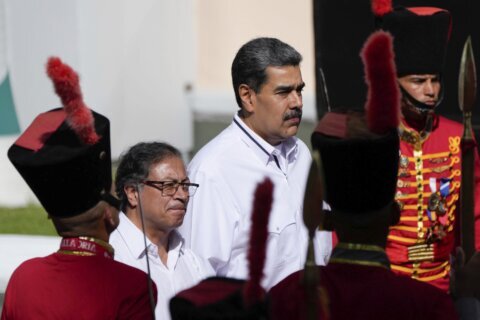For small investors, the usual appeal of exchange-traded funds, or ETFs, is that they are easy ways to gain exposure to the market and have low fees. The tradeoff has often been that ETFs themselves are fairly specialized, making it harder to achieve diversification.
What if there were funds that could do both?
[Sign up for stock news with our Invested newsletter.]
A small class of ETFs attacks this problem by buying other ETFs. So-called funds of funds diversify themselves within their chosen investment strategies by consolidating other funds and often switching between them as market conditions demand.
“The advantage for individual investors is that it saves them time in researching individual ETFs and doing asset allocation,” said Aniket Ullal, head of ETF data and analytics at CFRA Research in New York. “It’s almost a package solution of asset allocation and ETF selection.”
One note of caution: Unlike many ETFs, the fund-of-funds style is not cheap. The reason is the extra layer of overhead they include. The manager of the fund-of-funds ETF has to be paid, and the people running each ETF in its portfolio also collect a fee.
Ullal and Todd Rosenbluth, head of research at ETF analyst firm VettaFi, were asked for solid choices in this category of fund. Here are eight ideas they offered:
| ETF | Expense ratio |
| Global X Thematic Growth ETF (ticker: GXTG) | 0.5% |
| SPDR SSgA Multi-Asset Real Return ETF (RLY) | 0.5% |
| iShares Core Moderate Allocation ETF (AOM) | 0.2% |
| SPDR SSGA Fixed Income Sector Rotation ETF (FISR) | 0.5% |
| QRAFT AI-Pilot US Large Cap Dynamic Beta and Income ETF (AIDB) | 0.75% |
| SPDR SSgA Global Allocation ETF (GAL) | 0.35% |
| First Trust Dorsey Wright Focus 5 ETF (FV) | 0.9% |
| Cambria Global Momentum ETF (GMOM) | 1.11% |
Global X Thematic Growth ETF (GXTG)
The idea of this fund is to hold other Global X funds that bet on long-term megatrends, with GXTG doing the work of trying to time which funds will be hot when, Rosenbluth says. Its top five holdings are all Global X funds that focus on the blockchain, artificial intelligence, social media, financial technology and data centers, respectively.
Its biggest overall bet is on the rise of clean energy, since the 10 funds it holds include both a renewable-energy fund that owns shares in mostly non-U.S. wind and solar power producers and a fund that focuses on businesses like Tesla Inc. (TSLA) and Albemarle Corp. (ALB) that make either electric car batteries or the lithium that goes into them.
GXTG is relatively inexpensive for similar funds, according to ETF Database. Its annual expense ratio of 0.5% of assets is lower than the 0.65% average for global equities funds. The fund is up almost 15% so far this year, but is still down 12% from last year because it took a pounding in late 2022.
Expense ratio: 0.5%
SPDR SSgA Multi-Asset Real Return ETF (RLY)
This $535 million fund from State Street is all about real assets, Ullal said. It strives for a mix of real estate, commodities and inflation-protected government bonds in a bid to make the fund a hedge against inflation, he added.
Its biggest holding is a natural resources fund, SPDR S&P Global Natural Resources ETF (GNR), that itself owns metals and petroleum companies like Exxon Mobil Corp. (XOM) and Australian copper producer BHP Group Ltd. (BHP). No. 2 is the SPDR S&P Global Infrastructure ETF (GII), whose biggest holdings include Spanish airport operator Aena SME SA (AENA.MC) and several U.S. utilities that also produce renewable power though less-regulated subsidiaries. The two funds between them comprise more than half of RLY.
RLY’s recent returns haven’t been anything special, with a 2.4% year-to-date drop. It has kept only a small position in commercial real estate, which has helped its performance as that industry has fallen this year. Watch for its outperformance if and when inflation, which has been dropping, turns upward again.
Expense ratio: 0.5%
iShares Core Moderate Allocation ETF (AOM)
Both Ullal and Rosenbluth tapped this moderate-risk fund blending equity and bond funds, which VettaFi calls a “one-stop shop for investors seeking a moderate strategy that falls between its aggressive and conservative counterparts.”
It’s about 60-40 in favor of bonds at the moment, with a BlackRock fund that invests in U.S. Treasurys and government-backed securities representing about half of its assets. The next-largest position is an S&P 500 stock index fund.
Together, the mix has helped AOM gain about 6% both in 2023 so far and for the last 12 months, meaning it was steady as she goes in late 2022. “For people who are more conservative and closer to retirement, it can earn more income,” Rosenbluth says.
Like a lot of bond funds, performance has been hurt by the price drops that come with rising interest rates. The fund has returned 6.2% this year, nearly all of it coming in June as inflation fears ebbed.
The fund benefits from relatively low annual fees of 0.2%, or $20 per $10,000 invested.
Expense ratio: 0.2%
SPDR SSGA Fixed Income Sector Rotation ETF (FISR)
This broad-based bond fund is designed to do asset allocation within the bond market, Ullal says, toggling between different classes of credit. At the moment, its top holdings include an intermediate-term Treasury bond fund and a mortgage-backed securities fund, with smaller positions in corporate-bond ETFs. All of its holdings are other State Street funds.
Despite its appealing-sounding strategy, the fund hasn’t been a star of late. It has eked out a narrow gain in its share price so far this year, all of it since late May. Its 2.6% dividend yield is also below its category average. Fees are considered about average at 0.5% of assets.
Expense ratio: 0.5%
[READ: High-Yield Stocks to Buy.]
QRAFT AI-Pilot US Large Cap Dynamic Beta and Income ETF (AIDB)
This incredibly young, actively managed fund is notable because it plans to use artificial intelligence to guide asset allocation within the bond market, Rosenbluth says. AIDB was created in May, and its $3.1 million in assets are split between only two options so far, with the vast majority in an S&P 500 index fund.
Over time, the approach should let AIDB respond nimbly to market swings between “risk-on” and “risk-off,” Rosenbluth says, moving from bonds to stocks and back depending on the outlook for interest rates and growth. Right now, it’s a bet on stocks. Keep in mind that AIDB doesn’t yet have much of a track record, and it’s quite thinly traded at the moment.
Expense ratio: 0.75%
SPDR SSgA Global Allocation ETF (GAL)
This $225 million fund is concentrated mostly on international markets, and mostly on stocks, as it uses other State Street funds for diversification. The portfolio will generally invest at least 30% of its assets in securities of issuers economically tied to countries other than the U.S., with 60% put into stock funds, according to State Street.
As of late June, its top holdings included an S&P 500-driven fund, one fund for emerging markets, another for Europe, and one chartered to invest in non-U.S. developed markets generally, whose current holdings feature European companies such as LVMH and Nestle. Ullal says it’s a more globally focused take on the moderate-risk diversification that the AOM fund offers.
So far this year, the fund is up about 6.3%. “This fund will appeal to investors looking to preserve capital, while also generating a meaningful current income without having to stomach excessive portfolio volatility,” VettaFi says.
Expense ratio: 0.35%
First Trust Dorsey Wright Focus 5 ETF (FV)
This fund is a momentum play that owns roughly equal amounts of five First Trust ETFs at a time, jumping into sectors that have generated the best recent returns, Rosenbluth says. “It’s a bet that winners will continue to win,” he says.
Right now, that means it’s invested in industrials, semiconductors, consumer discretionary, food and beverages, and internet stocks. The fund’s shares are up 2.5% this year and up 8.2% for the last 12 months — meaning it beat the market in late 2022 but has lagged this year’s gains.
Expense ratio: 0.9%
Cambria Global Momentum ETF (GMOM)
Another momentum fund, Ullal said this one is notable because it will buy funds from fund families other than its own sponsor. Cambria says it targets up to 50 different funds, and the “unconstrained” fund might buy funds in stocks, bonds, commodities or currencies. Right now, that means the 8-1/2-year-old fund’s biggest holdings are the Cambria Global Value ETF (GVAL), an international value stock fund, and the Cambria Emerging Shareholder Yield ETF (EYLD), a dividend stock fund. It also owns BlackRock technology, consumer and industrials funds, the Graniteshares Gold Trust (BAR), and a WisdomTree emerging markets debt fund. Funds are rotated twice a month using a proprietary formula.
Mash this eclectic approach together, and it adds up to 3.2% annual returns in net asset value over the life of the fund as of May 31, but the fund is down 2.7% so far this year.
Expense ratio: 1.11%
More from U.S. News
8 Stocks to Buy If You’re Over 50
6 Steps to Get Started With ESG Investing
7 Best Dividend ETFs to Buy Now
Fund of Funds: 8 Great ETFs That Hold ETFs originally appeared on usnews.com
Update 06/27/23: This story was published at an earlier date and has been updated with new information.







